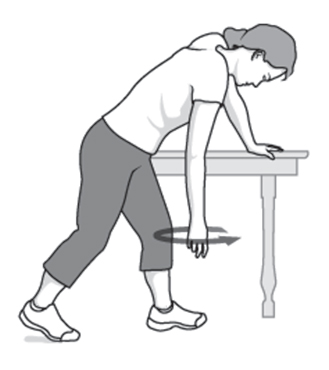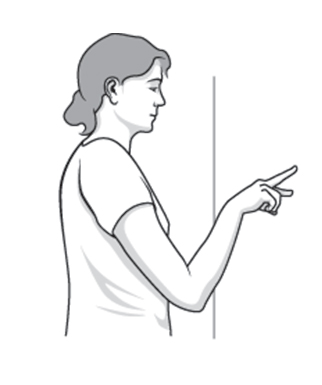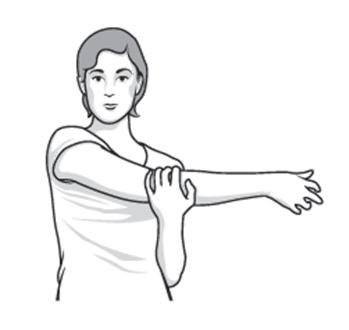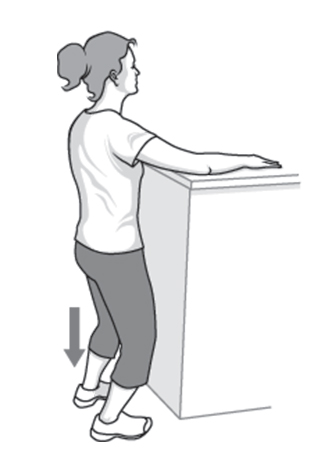This year I was affected by the same syndrome in my right shoulder for the past few months and recovering now after taking medicines/physiotherapy and proper exercises as advised by the Doctor.
On both the occasions initially I had severe pain in the shoulder which increased during nights while lying on the bed. I was unable to lift the hand above a certain level due to stiffness and pain in the shoulder.While typing in Laptop there was severe pain in the wrist and shoulder.This was the main cause of my keeping away from posting articles in my blog and restricting my activities in Laptop as per Doctor's advice.
I give below the details of Frozen shoulder, its symptoms and treatments available for the same compiled from various sites.
What is frozen shoulder?
Frozen shoulder (adhesive capsulitis) is stiffness, pain, and limited range of movement in your shoulder . The term adhesive capsulitis implies that the shoulder joint capsule has adhesions and inflammation that limits the motion of the shoulder.
It may happen after an injury or overuse or from a disease such as diabetes or a stroke. The tissues around the joint stiffen, scar tissue forms, and shoulder movements become difficult and painful. The condition usually comes on slowly, then goes away slowly over the course of a year or more.
What Are the Symptoms of a Frozen Shoulder?
You become aware of a frozen shoulder when it begins to hurt. The pain then causes you to limit your movement. Moving the shoulder less and less increases its stiffness. Before long, you find that you can’t move your shoulder as you once did. Reaching for an item on a high shelf becomes difficult, if not impossible. When it’s severe, you might not be able to do everyday tasks that involve shoulder movement such as dressing.
What causes frozen shoulder?
Frozen shoulder can develop when you stop using the joint normally because of pain, injury, or a chronic health condition, such as diabetesor a stroke. Any shoulder problem can lead to frozen shoulder if you do not work to keep full range of motion.
Frozen shoulder occurs:
- After surgery or injury.
- Most often in people 40 to 70 years old.
- More often in women (especially in postmenopausal women) than in men.
- Most often in people with chronic diseases.
As people sit in front of the computer with poor posture for extended periods of time using their mouse in a repetitive fashion, this increased instability of the shoulder begins to cause friction and inflammation of the shoulder joint (GH Joint). This increased inflammation combined with stress will cause increased pain and self limiting movement of the shoulder. This limited movement of the shoulder leads to a diagnosis of a frozen shoulder.
- Painful stage - the shoulder becomes stiff and then very painful with movement. Movement becomes limited. Pain typically worsens at night.
- Frozen/adhesive stage - the shoulder becomes increasingly stiff, severely limiting range of motion. Pain may not diminish, but it does not usually worsen.
- Thawing stage - movement in the shoulder begins to improve. Pain may fade, but occasionally recur.
A few tests may also be necessary. Your doctor might do a magnetic resonance imaging scan (MRI) to rule out a tear in your rotator cuff or other pathology. X-rays may also be taken to check for arthritis or other abnormalities. You may need an arthrogram for the X-ray, which involves injecting dye into your shoulder joint so that the doctor can see its structure.
How is it treated?
You can leave a frozen shoulder untreated, but the pain and stiffness can remain for up to three years. A combination of the following can speed up your recovery:
Physical Therapy
Physical therapy is the most common treatment for a frozen shoulder. The goal is to stretch your shoulder joint and regain the lost motion. It can take anywhere from a few weeks to nine months to see progress. A home exercise program of gentle range of motion exercises is important. If you don't see progress after six months of intense, daily exercises, speak to your doctor about other options.
Medications
To treat the pain and reduce your joint inflammation, your doctor may recommend an anti- inflammatory medication like aspirin, ibuprofen, or naproxen sodium. A steroid injection you’re your shoulder joint may also help.
Home Care
Placing an ice pack on your shoulder for 15 minutes at a time several times per day can help to decrease pain. If you’re working with a physical therapist, the exercises can be done at home. Your physical therapist will provide instructions on the types of exercises you must do, how often to do them, and when to push yourself harder. Most people with a frozen shoulder can improve their condition without surgery.
Surgery
If physical therapy doesn’t improve your condition, surgery is an option. From a surgical standpoint, your options are to manipulate the shoulder and put it through a full range of motion under a general anesthetic to help break up any adhesions. Another option is arthroscopic surgery. This type of surgery involves making a small cut in your shoulder and using a camera called an “arthroscope” to remove scar tissue or release it. This allows the shoulder to recover its lost motion. If your frozen shoulder is the result of an injury, surgery is usually more successful if it’s performed within a few weeks of the injury.
Surgery is usually done on an outpatient basis. Your stitches will most likely be removed after 10 days. Postoperative physical therapy is usually required as well. Many patients have their full range of motion back within three months.
Surgery carries risks, so talk with your doctor before deciding on any procedure. Some people still have pain or stiffness afterward or can’t handle the pain of physical therapy.
Can frozen shoulder be prevented?
Gentle, progressive range-of-motion exercises, stretching, and using your shoulder more may help prevent frozen shoulder after surgery or an injury. Experts don't know what causes some cases of frozen shoulder, and it may not be possible to prevent these. But be patient and follow your doctor's advice. Frozen shoulder nearly always gets better over time.
Exercises for Frozen shoulder:
Shoulder motion is the primary treatment for frozen shoulder. It is important to continue
to use the arm as much as can be tolerated while healing. If the shoulder is overly protected
from motion the condition will worsen.
The application of a hot pack or warm shower prior to performing these exercises, and the
application of an ice pack to the shoulder afterward will make the exercises more tolerable.
While keeping the shoulder active is good at preventing the progression of this malady, moving the shoulder through all of the planes of motion is required to fully recover. The exercise program that follows is intended to increase motion in all planes of shoulder motion. Remember that healing from a frozen shoulder will take time, in some cases a lot of time. These exercises need to be done every day, not just the days the gym or the physical therapist’s office is open. You will need to push yourself out of the comfort zone to obtain healing.
Some of the daily exercises for Frozen shoulder are given below:
Pendulum Stretch
1. Begin using the weight of your arm without any added weights, gradually incorporating light dumbbells or kettlebells into the routine
2. The frozen shoulder arm follows the body’s motion
3. Keep back straight, core (trunk muscles) tight, feet shoulder width apart
4. Support opposite arm to allow the affected arm to hang straight down with full relaxation of that shoulder’s muscles
5. Using the motion of your body to create shoulder motion, sway your body
6. Start with small circles, gradually increasing to larger circles
7. Perform 20-25 circles in each direction




Over-the-door pulley systems are a practical way to mobilize the shoulder in multiple planes of motion. The well arm pulls the frozen shoulder into various stretches. Pulley exercises can be used to perform many of the same range of motion exercises
 Other treatments available for Frozen Shoulder syndrome:
Other treatments available for Frozen Shoulder syndrome:
Homeopathy treatment:
https://www.drhomeo.com/joint/homeopathic-remedies-for-frozen-shoulder-treatment/
Ayurvedic treatment:
https://www.epainassist.com/alternative-therapy/ayurvedic-treatment-for-frozen-shoulder
Acupressure /acupuncture treatment, and Ozone Injection treatments are also given for Frozen shoulder.
While keeping the shoulder active is good at preventing the progression of this malady, moving the shoulder through all of the planes of motion is required to fully recover. The exercise program that follows is intended to increase motion in all planes of shoulder motion. Remember that healing from a frozen shoulder will take time, in some cases a lot of time. These exercises need to be done every day, not just the days the gym or the physical therapist’s office is open. You will need to push yourself out of the comfort zone to obtain healing.
Some of the daily exercises for Frozen shoulder are given below:
Pendulum Stretch
1. Begin using the weight of your arm without any added weights, gradually incorporating light dumbbells or kettlebells into the routine
2. The frozen shoulder arm follows the body’s motion
3. Keep back straight, core (trunk muscles) tight, feet shoulder width apart
4. Support opposite arm to allow the affected arm to hang straight down with full relaxation of that shoulder’s muscles
5. Using the motion of your body to create shoulder motion, sway your body
6. Start with small circles, gradually increasing to larger circles
7. Perform 20-25 circles in each direction

Finger walk

Face a wall three-quarters of an arm's length away. Reach out and touch the wall at waist level with the fingertips of the affected arm. With your elbow slightly bent, slowly walk your fingers up the wall, spider-like, until you've raised your arm as far as you comfortably can. Your fingers should be doing the work, not your shoulder muscles. Slowly lower the arm (with the help of the good arm, if necessary) and repeat. Perform this exercise 10 to 20 times a day.
Cross-body reach

Sit or stand. Use your good arm to lift your affected arm at the elbow, and bring it up and across your body, exerting gentle pressure to stretch the shoulder. Hold the stretch for 15 to 20 seconds. Do this 10 to 20 times per day.
Armpit stretch

Using your good arm, lift the affected arm onto a shelf about breast-high. Gently bend your knees, opening up the armpit. Deepen your knee bend slightly, gently stretching the armpit, and then straighten. With each knee bend, stretch a little further, but don't force it. Do this 10 to 20 times each day.
Pulley Exercises Over-the-door pulley systems are a practical way to mobilize the shoulder in multiple planes of motion. The well arm pulls the frozen shoulder into various stretches. Pulley exercises can be used to perform many of the same range of motion exercises

Homeopathy treatment:
https://www.drhomeo.com/joint/homeopathic-remedies-for-frozen-shoulder-treatment/
Ayurvedic treatment:
https://www.epainassist.com/alternative-therapy/ayurvedic-treatment-for-frozen-shoulder
Acupressure /acupuncture treatment, and Ozone Injection treatments are also given for Frozen shoulder.